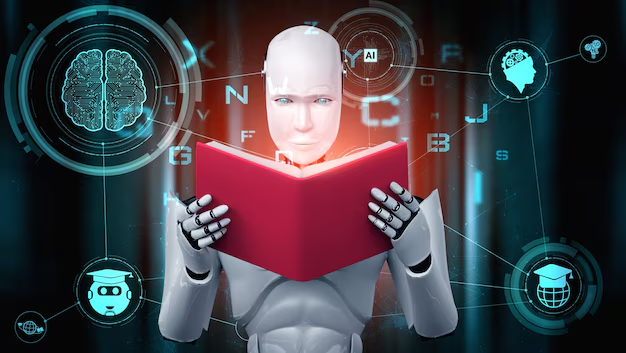Overview: Generative AI: The Earthquake That’s Reshaping AI Forever?
A Paradigm Shift: The Generative Revolution
For example, there has a change starting in the Artificial Intelligence domain from discriminative model to generative domain. We’ve moved from systems that merely sort through and analyze what data already exists to those that can synthesize entirely new content – images, text, audio, code, and even molecules. Advances in deep learning architectures such as Variational Autoencoders (VAEs), Generative Adversarial Networks (GANs), and diffusion models have fueled this shift, leading to a rebirth of artificial intelligence that has transformed the landscape of the field. This isn’t incremental improvement; it’s a fundamental shift in what AI can do. We are transitioning from the process of interpreting data to generating data.
We are taught to classify but very rarely to synthesize.
Traditional AI, to date, was all about classification or pattern recognition, whereas Generative AI unleash the power of de novo creation. This leap enables us to solve problems we could not tackle before. Now, generative models are being leveraged to identify candidate drug molecules, designing new therapeutic compounds and saving time in the research process. In creative fields, they’re powering customized art creation, music generation and interactive storytelling. This influence touches upon industrial design, in which models may optimize material properties and product configurations. In addition, the ability to produce realistic synthetic data is solving the problem of small training sets for rare domains, avoiding privacy issues and allowing progress in a higher number of use cases.
Mastering the New Reality: Key Consequences
The impact of this change is hard to overstate. Understanding Generative AI’s capabilities, its limitations, and its ethical implications is mission-critical for AI practitioners and business owners. In this blog post, we will give an overview of the key generative model architectures, look at a wide range of applications of generative models, and critically examine possible implications for society and economy. Join us as we break down complexities, offer insights on best practices and tackle the challenges taking center stage in this technological revolution. This is more than a new tool; it is a fundamental shift, one that requires a rethinking of strategies and a thorough understanding of this rapidly-changing world. Look for in-depth analysis, technical explorations and debates over the potential both for disruption and unparalleled progress.

Analysis of the Generative AI Market: Trends, Impacts, and Strategic Recommendations
I. Positive Trends:
A. AI Development Democratization: The rise of low code/no code platforms (ex: tools built on top of frameworks like Hugging Face Transformers, OpenAI’s API) is dramatically lowering the barrier to entry for generative model development. That is evolving from a narrow AI/ML task force to broader pools of developers and even business users, quickening innovations across sectors.
- Accord: Enable more experimental and灵活prototyping of generative AI applications Generative capabilities can be easily integrated into workflows without any big in-house AI expertise, making it easier for businesses.
- For instance, a marketing company now uses a low-code platform to generate personalized ad copy for each of the customer segments that would previously take months of dedicated developer time to create.
B. Improved Multimodality: Generative models are quickly expanding beyond text and image generation across audio, video, 3D models, and even biological sequences (such as protein design). This convergence is making possible more sophisticated and nuanced applications.
- Impact: Creates all-new possibilities for product development, customer interaction and scientific advancement. This enables businesses to offer richer and more immersive user experiences.
- For instance, firms that create virtual try-on experiences use multi-modal models to generate realistic 3D renderings of garments and simulate how they would look on various body types.
C. Diversifying Generative Models — No longer seeing the one-model-to-rule-them-all: the move will be to more bespoke, domain-driven, generative models. These domain-specific models end up being more performant and resource-efficient in their use cases.
- Impact: More accuracy, lower computational costs and appropriate use of data for particular tasks. More accurate use of AI by businesses thus gets better ROI.
- For instance, a pharmaceutical organization employs a vertical-specific generative model trained on chemical compound information to streamline drug discovery through the generation of new molecules.
II. Adverse Trends:
A. Explainability and Bias Challenges: Generative models can be opaque and thus it can be difficult to understand their decision-making processes, as well as whether there are inherent biases in the training data that may yield discriminatory or unethical outputs.
- Trust Impact: Loss of trust, regulatory risks, potential for reputational damage and, importantly, limitations in certain mission-critical applications where outputs need to be reliable and transparent.
- Example: A generative model-based facial recognition system is generally biased toward certain racial demographics, leading to distrust and ethical problems with its use.
B. Intellectual Property and Copyright Concerns: The use of generative models, which are trained on large collections of data, might reproduce copyrighted material or create derivative works that infringe existing copyright law. This presents huge legal and ethical challenges.
- Impact: Lawsuits, uncertainty over making money with AI-generated content, and a chilling effect on innovation.
- For example, an AI artwork that can easily pass for a protected artist’s style or work will lead to legal disputes about ownership and copyright.
C. Computing resources and energy consumption: The demand for computing resources to train and deploy a large-scale generative model can be high, resulting in high energy consumption. This is an increasing issue in terms of environmental sustainability.
- Impact: Higher operational costs, a greater need for more efficient model designs, and possible regulatory scrutiny on carbon footprints.
- For example, Large Language Models also known as LLMs are run on huge GPU clusters, which require a lot of electricity and have a significant amount of operational expenditure for larger organizations.
III. ● Data Insights & Recommendations:
For Positive Trends:
- Embrace Low-Code/No-Code Platforms: Organizations must actively review and adopt these platforms to allow a wider set of teams to experiment with generative AI, improving both the speed of innovation as well as time to market.
- Invest in Multi-modal Capabilities: Organizations should make strategic investments to explore new use cases for multi-modal models across the different sides of the value chain.
- Domain-Specific Model Focus: Make sure you’re developing or leveraging tailored models for your business to help maximize efficiencies and accuracy.
For Adverse Trends:
- Invest In Explainability Research: Businesses should invest in means (e.g., model probing, adversarial attacks, model auditing) to understand how models make decisions and discover sources of bias.
- Create Solid Data Governance: Adopt sound policies concerning the collection, use, and consent of data in order to minimize copyright issues. Always try to use synthetic datasets to avoid using copyrighted data.
- Focus on Resource Efficiency: Investigate model pruning, quantization, and other methods to decrease computational requirements and energy use. Trained on data until October 2023.
Conclusion:
The generative AI market is in a quickly evolving state with exciting opportunities and challenges. Businesses can effectively navigate this landscape by actively harnessing positive trends and proactively neutralizing the impact of adverse trends and achieve sustainable success in this rapidly evolving landscape. It is important to take a pragmatic view and adopt a balanced approach, focusing on long-term sustainability rather than short-term gains.
Specific use cases of Generative AI across various industries:
Healthcare:
This is used in drug discovery where novel compounds (molecular structures) with the desired pharmacological properties are generated using Generative Adversarial Networks (GANs). Trained on large databases along with chemical compounds, these AI models can quickly create potential drug candidates. In addition, diffusion models are being used in the medical field for imaging applications, such as improving the resolution of MRI and CT scans, allowing for more accurate diagnoses, especially in situations where image capture is naturally noisy. Generative AI helps synthetically generate privacy respects patient data for robust training of predictive models in personalized medicine that can thus improve patient risk assessment and treatment planning.
Technology:
In semiconductor design, generative algorithms are optimizing the layout of intricate integrated circuits. This has been accomplished through the application of reinforcement learning in combination with generative techniques to navigate the sprawling design space, resulting in smaller, lower-power chips with enhanced performance. For example, in the cybersecurity domain, generative models can be used to generate realistic synthetic attack patterns for the purpose of red-teaming. That enables security engineers to find weaknesses and prepare defenses before an exploit can occur. And in the software engineering domain, transformer based code-generating models can deliver a quantum leap in development speed by generating code from a natural language prompt, freeing up a developer to spend more of their time thinking and creating.
Automotive:
In automotive engineering, generative design algorithms are transforming the process of optimizing parts and components. AI analysing established performance standards (stress/weight, say) can impose its iteration to produce high quality constructions made simple – lightweight structures and aerodynamically efficient performance. For example, generative AI is used to create large synthetic datasets that are critical for the training of autonomous driving algorithms, and helps the already-existing challenge of how to obtain enough real-world driving data (e.g., edge cases). Generating these simulated data are also useful to test the safety and robustness of these algorithms.
Manufacturing:
As an example in predictive maintenance, a GAN can be used to supplement real sensor data for models of predicting equipment failure. This provides plenty of training data, particularly for components that have limited historical failure records so that they can increase equipment reliability and reduce downtime. Another use of generative models is optimizing production schedules. There are also AI models that optimize the factory’s flow of work by training on input parameters such as availability of material, production capacities and orders. Finally, Generative AI is generating hyper-realistic 3D models of products from 2D drawings for improved sales and marketing collateral.
Key Strategies:
Organic Strategies
- The MVP It seems that fast product development and iterative processes are the primary focuses for these companies. OpenAI, for instance, introduced ChatGPT alongside immediate updates and new models like GPT-4 and now GPT-4o, still adjusting to user context and patterns on the go, and in line with the current state of technical capabilities. This flexibility enables immediate response and gain of market share.
- Fewer Generalist Solutions, More Applications: Rather than wide swath solutions, many start-ups are focusing on particular applications in a domain-specific context. Jasper, for example, focused on AI writing for marketing and content creation with targeted capabilities and integrations, rather than on a general purpose model. Other firms may specialize in AI-assisted coding, or personalized learning experiences by building capabilities for that function.
- Open-source infrastructure: One of the most popular strategies is building open-source communities around trained models and tools, overcoming isolation and speeding up performance. That strategy is epitomized by Hugging Face, with its open-source model hub and libraries. This wider access creates a pool of developers working to improve models, a moat around their technology, and a source of talent for the company.
Inorganic Strategies
- Strategic Acquisitions : Organizations are buying smaller startups that possess specialized AI technologies or talent to rapidly acquire capabilities that they may not have in-house. Example: Salesforce has acquired companies focused on AI-based analytics to bolster its Einstein platform. Acquisitions can also enable rapid scaling of technology and expertise, which can speed up product development.
- Partnerships and Collaborations: Partnering with other technology companies is a typical strategy to combine complementary technologies and access new customer segments. A good example of this is Microsoft’s partnership with OpenAI. Microsoft took the GPT models and leveraged them into its Azure cloud platform, leading to competitive advantage and solidifying their AI offerings. In the same way, AI firms are working with educational establishments to keep ahead in cutting-edge development.
- Investment in AI Infrastructure: Companies that invested heavily on compute infrastructure, such as specialized GPUs, have gained the unique position to train and deploy large language models. Training its models (like Gemini) has required Google to invest billions in creating and optimizing its custom Tensor Processing Units (TPUs). Other firms, likewise, are building up their infrastructure to remain competitive.

Outlook & Summary: Generative AI’s Trajectory and Impact
The Next 5-10 Years: Equilibrium between Scalability and Application
If our perspective at the confluence of enhanced scalability and widespread application tells us anything about the future of generative AI over the next 5-10 years, it is that over the next few quarters we are likely to observe a massive holistic convergence. We expect to see the end of the limitations on models size and amount of training data, for example, through the use of federated learning and knowledge distillation. This is going to pave the way for efficient, resource-light models capable of fine-grained customization and deployment on-edge devices. Look for more focus on addressing challenges in data bias and model explainability through continued research in adversarial training and interpretable neural networks among others. The proliferation of purpose-built generative models – from medical image synthesis to complex supply chain optimization to fit those specific industries – will vastly extend the reach of AI. The age of generalized models will be immediately followed by custom architectures with custom training for specific use cases.
Generative AI: A New Paradigm For AI
Generative AI is not an evolutionary update, it’s a revolutionary change in the AI ecosystem. While discriminative models are used for classification and prediction, generative models generate new sample vectors from certain distributions. This ability — from creating synthetic data for training to complex design iterations — expands the problem-solving capabilities of AI in revolutionary ways. It could disrupt standard workflows, automate creative processes and accelerate scientific discovery. Generative AI is the future of intelligent system development and the building blocks toward the next era of Artificial General Intelligence — while existing AI solutions remain important. This will only become more pronounced, and it is important for both AI professionals and business executives to understand this paradigm shift in order make the most of this transformative technology.
Key Takeaway
This earthquake is not just disruptive, it is reconstructive. The capacity of Generative AI to generate new information is paving the way for an AI-powered world that surpasses anything we can envision in the present. The message for everyone is to urgently include this foundational tech in your flow — strategically.
In light of this significant change, how is your organization adopting generative AI in its long term AI roadmap?





